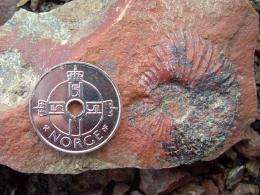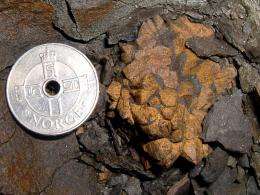Dinosaurs out in the cold

A major drop in temperature 137 million years ago briefly interrupted the warm, equable climate of the Cretaceous Period. The water temperature in the Arctic Ocean fell from around 13 C to between 4 and 7 C, possibly causing the poles to freeze over. Gregory Price from the University of Plymouth, UK and Elizabeth Nunn from Johannes Gutenberg University Mainz, Germany investigated rock samples with fossil belemnites and glendonites from Svalbard in order to determine the temperature of the Arctic Ocean between 140 and 136 million years ago. Such paleoclimate reconstructions help to improve predictions for future climate and environmental development and to gauge the impact of the human race on climate. The temperature of the oceans plays an important role in the history of the Earth's climate.
Current findings indicate that the global climate during the Cretaceous Period was warm and equable with high atmospheric CO2 values, although scientists have already speculated that this global warmth may have been punctuated by colder episodes. The latest research carried out by Price and Nunn proves that there was a brief cold episode approximately 137 million years ago. "Temperatures fell drastically compared with the average water temperatures of 13°C or even 20°C in the Arctic region during the rest of the Cretaceous Period," states Nunn. Dinosaurs inhabited the polar regions during the Cretaceous greenhouse period. While marine reptiles such as pliosaurs and ichthyosaurs may have migrated with the onset of the cold snap, it is not clear how dinosaurs would have handled the colder conditions.

During the course of their work, Nunn and Price investigated rock outcrops on Svalbard, which provide an ideal sequence of marine deposits offering paleontologists insights into a time when the area was still a flat sea. Some rock layers from the Valanginian Stage of the Lower Cretaceous are rich in belemnites, i.e., fossils reminiscent of modern squid, and glendonites, calcium carbonate crystal aggregates of between 2 and 3 cm in size. Scientists can use these relics to determine the relationship between 2 oxygen isotopes and use these findings to draw conclusions about the water temperature. "If global temperatures fall, the oxygen isotope O16 is increasingly incorporated into polar ice and the isotope O18 is consequently enriched in the seawater relative to O16. Belemnites and glendonites store this ratio," Nunn explained.
Dr. Elizabeth Nunn joined the Department of Applied and Analytical Palaeontology in the Mainz Institute for Geosciences from the University of Plymouth 2,5 years ago. She is currently carrying out research to determine whether, and to what extent, seasonal temperature fluctuations occurred during the Early Cretaceous interval. Such changes from summer to winter values or vice versa are probably recorded during the short life span of the belemnites - they probably only lived between 1 and 3 years - and could be identified today using modern analytical methods.
More information: Gregory D. Price and Elizabeth V. Nunn: Valanginian isotope variation in glendonites and belemnites from Arctic Svalbard: Transient glacial temperatures during the Cretaceous greenhouse, Geology 2010; 38; 251-254. doi:10.1130/G30593.1
Provided by Johannes Gutenberg University Mainz















